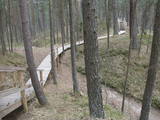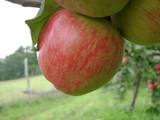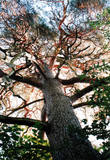| Nr | Nosaukums | Apraksts |
|---|---|---|
|
Viena no augstākajām Latvijas celtnēm ar vienu no augstākajiem skatu laukumiem (65 m). Paveras izcila Vecrīgas un Rīgas ainava, kā arī Daugavas (līdz Rīgas HES dambim) un Pārdaugavas skati. Labi redzami blakus esošie Rīgas centrāltirgus paviljoni. |
||
|
Pēc izmēriem - salīdzinoši nelielais dabas parks, kas atrodas Jūrmalas pilsētā, veidots piekrastes kāpu, veco priežu audžu un piekrastes biotopu aizsardzībai. Parka teritorijā atrodas viena no atraktīvākajām pierīgas dabas izziņas takām, kas veidota interesanta kāpu veidojuma – līdz 17 m augstās Ragakāpas apkārtnē. Tā ir lieliska iespēja ikvienam iepazīt kāpu biotopus un to apdzīvotājus – augus, putnus, kukaiņus u.c., t.sk. simtgadīgas priedes, nebraucot tālu no valsts galvaspilsētas. |
||
|
Atrodas Obinitsa ciemā, vasarā atvērts katru dienu, ziemā pēc pasūtījuma. Baltmaizes un rupjmaizes cepšanas ar ieraugu mācību darbnīcas. Kafejnīcā cep klona maizi bez formas, maizi ar sēklām, dažādas baltmaizes. |
||
|
Ap 200 m garajā un izstieptās formas laukumā no 16. – 20. gs. atradās Liepājas tirgus. Laukuma malās tolaik bija izveidojusies vienstāvu apbūve – iebraucamās sētas, viesnīcas un dārzi. Līdz ar Pētertirgus izveidi 1910. gadā, izmainījās arī laukuma apveidi un to ieskaujošā apbūve. Laukuma DA malā slejas iespaidīgā Liepājas Svētās Annas Luterāņu baznīca. |
||
|
Laipu taka Planču purvā. Garums 0,5km, laiks aptuveni 0,3 h. Viens no retajiem Latvijas brīvdabas objektiem, kur informācija ir izvietota Braila rakstā. Atrodas Ziemeļvidzemes biosfēras rezervātā. |
||
|
Saimniecība atrodas ļoti skaistā vietā - Talsu pauguraines rietumu nogāzē, no kuras paveras skats uz Talsiem un to apkaimi. Atvērta saimniecība, kurā audzē un pārstrādā ābolus (žāvēti, ābolu čipsi, sulas). Viesus gaida izzinoša ekskursija, produkcijas iegāde un degustācija. Atrodas īpaši aizsargājamā dabas teritorijā – Talsu pauguraines dabas parkā. Vasaras sezonā ceļotājiem piedāvā telšu vietas. Rāda, kā veidot augļkoku vainagu. Saimniecības dārzos, kas plešas Talsu pauguraines nogāzēs, ir savāktas dažādas ābeļu šķirnes - saimniece veido un attīsta vietējo šķirņu kolekciju. Pie saimniecības uzstādīts arī informatīvs stends, kas iepazīstina ar Talsu pauguraines dabas parka nozīmīgākajām vērtībām. Saimniecības teritorijā tiek piedāvāta svinību un ceremoniju vieta; pieejama stikla oranžērijas un teritorijas noma pasākumiem. Piedāvājums jaunlaulātajiem - ābeles stādīšana “Kurzemnieku” paradīzes dārzā, foto sesijas. |
||
|
Kaut arī muiža sāka veidoties 16. gs., tagad redzamais komplekss tapis g.k. laikā no 1897. – 1902. g. un bijis grāfa Jozefa Tiškeviča un viņas sievas īpašums, kas tāpat kā daudzi citi, pēc 1940. g. tika nacionalizēti. Arī muižas liktenis līdzinās daudzu Baltijas valstu muižu piedzīvotajam. Sākumā te bija sanatorija, pēc tam – pionieru nometne, bet vēlāk - valstij piederošs tūrisma uzņēmums. 1995. g. muižas kompleksu savā pārraudzībā pārņēma nacionālā parka administrācija. Neorenesanses stilā celtā pils ir labi redzama pāri Galves (Galvė) ezeram no Traķu ezerpils puses. Užutraķu muiža ir iecienīta dažādu kultūras un mākslas pasākumu norises vieta. 2011. g. šeit notika vērienīgi muižas un skaistā parka ar dīķiem un skatu laukumiem (veidojis franču biologs E. F. Andrē) rekonstrukcijas darbi. No Traķu centra līdz Užutraķu muižai var ērti nokļūt ar divriteni. |
||
|
Viena no lielākajām Austrumeiropas baznīcām (līdz 16. gs.) un vienīgā Igaunijas viduslaiku baznīca ar diviem torņiem. Celta laikā no 13. – 16. gs., sagrauta Livonijas karā. Kora daļā atrodas Tartu universitātes muzejs (agrāk – bibliotēka). Torņi ir restaurēti un tajos izveidoti skatu laukumi. |
||
|
0,2 km ziemeļaustrumos no Lībiešu tautas nama no Mazirbes – Košraga ceļa redzamas Seppes. Saimniecības klētiņu ar piedurpakšu baļķu savienojumiem stūros pagājušā gadsimta 20 – 30 gados cēlis Mazirbē no Sāmsalas ienākušais igaunis – zvejnieks un namdaris Jēkabs Jaga. Ceļa otrajā pusē redzami Kalši - 20. gs. sākumā celta dzīvojamā ēka. Tā mūsdienās ir atjaunota, saglabājot Mazirbes Brausku ķieģeļu ceplī dedzinātos ķieģeļus mājas sienās. |
||
|
Lielpaugurā ir vairākas augstākās vietas – Laktas kalns (250 m v.j.l.), Egļu kalns (268 m v.j.l.) un Bākūžu kalns (272 m v.j.l.). Tos savieno zemes ceļš, kuru vērts izstaigāt un pameklēt interesantus skatu punktus. Ļoti labs skats uz Vidzeme augstienes pauguru mugurām paveras no Laktas kalna ziemeļu nogāzes.
|
||
|
Iespēja iepazīties ar savvaļā augošiem un kultivētiem ārstniecības augiem, pašiem tos ievākt, izbaudot Latgales neskarto dabu, sasiet ārstniecības augu slotiņu veselībai un pirtij. Nodegustēt augu tējas lauku klusumā vai tieši otrādi - kopā ar „Muzikantu ciema” muzikantiem, piedaloties jautrās aktivitātēs, iepazīties ar bagāto latgaliešu tautas dziesmu un polku pūru. |
||
|
Viens no retajiem brīvdabas objektiem, kas liecina par pasaules mērogā unikālo Baltijas ceļu, kur rokās un vienā ķēdē sadevās trīs valstu – Lietuvas, Latvijas un Igaunijas iedzīvotāji. Piemineklis atrodas pie bijušā Unguriņu robežas pārejas punkta pie Latvijas – Igaunijas robežas. Uzstādīts 2009. gada 23. augustā, Baltijas ceļa 20. gadadienā. To veidojis metālmākslinieks Andris Dukurs. |
||
|
Darbnīcā ražo visu saimniecībā nepieciešamo – solus, galdus, pakaramos, virtuves piederumus, pirts baļļas, mucas, lieliskus suvenīrus no koka u.c. Darbus var iegādāties, kā arī veikt savu pasūtījumu. Ekskursijas. Skalu grozu pīšanas demonstrēšana, var mācīties paši pīt grozus, iepriekš piesakoties. |
||
|
Marķēto kājāmgājēju maršrutu (nepieciešams ceļvedis vai gids) sākums meklējams pie 1878. g. celtajām Jēču dzirnavām, pie kurām izveidots dendroloģisks parks un akmeņu kolekcija. Noskaidrosiet, kas ir drumlins, morēna, iepazīsiet dažādus purvu tipus, savdabīgos Pugu akmeņu krāvumus un Kraujiņu akmeni. Nepieciešami ūdensnecaurlaidīgi apavi!
|
||
|
Atrodas Taurenē, Gaujas labajā krastā. Muižas apbūve, kurā ietilpst pils (19. gs. 80. gadi, arhitekts – R. G. Šmēlings, historisma un neoklasicisma stils), senie alus pagrabi, klēts, vecā pils un parks, veidojies 19. - 20. gs. Šobrīd muižas pilī atrodas Taurenes pagasta pārvalde un kultūras nams. Muižas kompleksā ietilpst ēka, kurā atrodas Vecpiebalgas novada tūrisma informācijas punkts un Taurenes novadpētniecības ekspozīcija (senajā ledus pagrabā). Parkā (ziemeļos no pils) uzmeklējams piemiņas akmens, kas veltīts komunistiskā terora upuriem. Pie Nēķena muižas sākās 0,4 km garā Cieres dabas taka, kas iepazīstina ar Gaujas krastu mitrājiem. |
||
|
Latvijas resnākā parastā priede (Pinus sylvestris).
|
||
|
1,8 km garā taka atrodas neparastā vietā – uz Cirīša ezera salas. Tās galvenās vērtības ir augu valsts un dzeņveidīgo putnu daudzveidība. Viens no apskates objektiem ir Upurkalns – sens pilskalns. Taka labiekārtota, izveidoti informācijas stendi, atpūtas vieta. Lai nokļūtu uz salas, no vietējiem jānomā laiva, vai jādodas ar savējo. Atrodas dabas parkā „Cirīša ezers”. |
||
|
Klasiskais Vecrīgas siluets baudāms no vairākām vietām: Mūkusalas ielas (starp Dzelzceļa un Akmens tiltu), Akmens tilta, A – B dambja, atpūtas vietas pie Hansabankas centrālā biroja, Vanšu tilta un Balasta dambja Ķīpsalā. Savienojot šīs vietas sanāks labs kājnieku vai velomaršruts. Savādāki skati pavērsies no kuģīšiem, kas sezonas laikā kursē pa Daugavu.
|
||
|
Atrodas Jūrmalciema austrumdaļā. Koka šķūnī sakrāti vietējo entuziastu savāktie Jūrmalciema iedzīvotāju sadzīves priekšmeti un amata rīki. Novadpētnieki te var uzzināt vērtīgu informāciju par ciema vēsturi un zvejnieku dzīvesveidu. |
||
|
Piemērots aktīviem gājējiem, kam patīk apvienot dabas vērošanu ar kultūrvides un vēstures izziņu. Šis ir ceļojums pa Baltijas iespaidīgākās upes – Gaujas senleju un tās pietekas – Amatas dziļo senleju. Abu upju krastos paceļas ainaviski devona perioda smilšakmens atsegumi. Līgatnes papīrfabrikas ciemats ir Eiropas mērogā izcils industriālā mantojuma piemērs ar savdabīgu – 19. – 20. gs. papīrfabrikas ciematvidi. Maršruta noslēgumā apskatāma Cēsu viduslaiku pils – varenākais viduslaiku Livonijas cietoksnis. Maršruta informācija no Latvijas Lauku foruma |
||





















